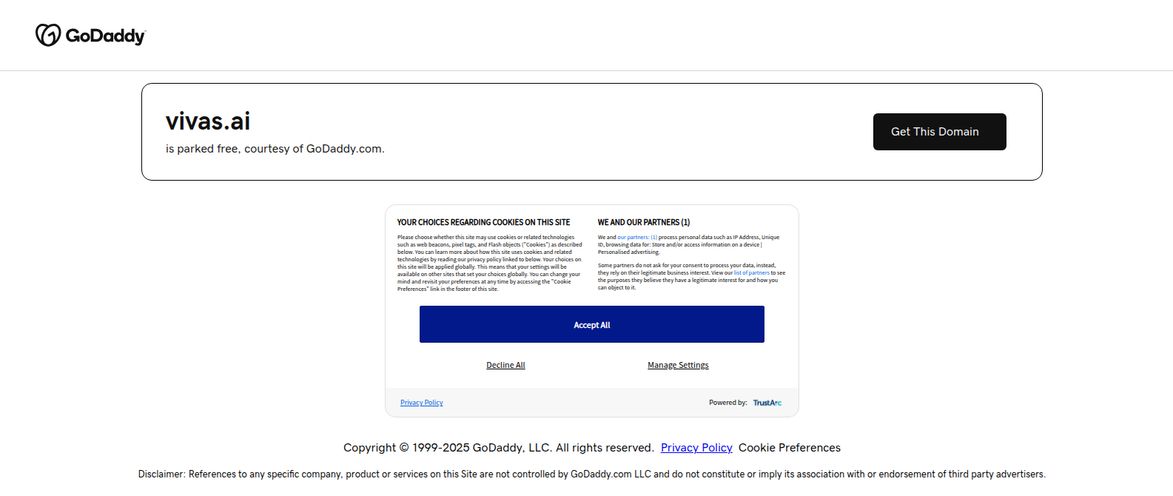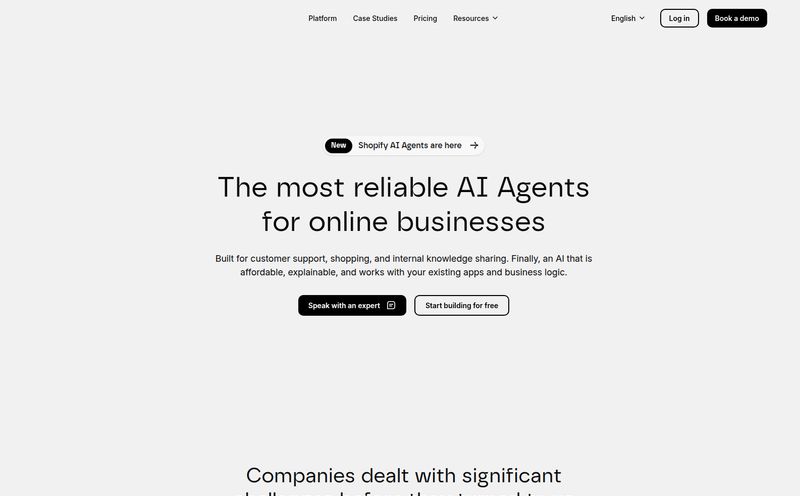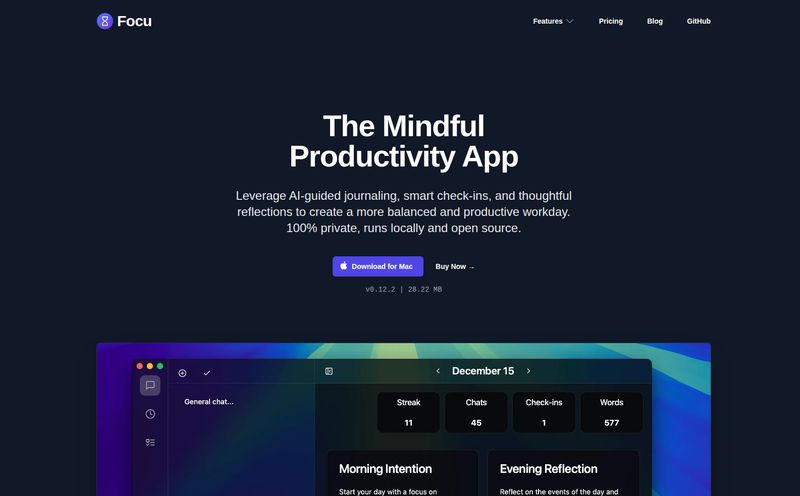I swear, some websites feel like a personal attack. You click on a link, hoping for a simple answer or a quick purchase, and BAM. You're hit with a wall of text, three competing pop-ups, a video that auto-plays, and a navigation menu with more options than a Cheesecake Factory menu. I’ve personally rage-quit more sites than I can count for this very reason. It’s not about being impatient; it’s about mental exhaustion.
In the world of UX and SEO, we have a term for this: cognitive load. It's the digital equivalent of trying to have a serious conversation in the middle of a loud rock concert. When you force a user's brain to work too hard just to figure out what to do next, they don't stick around. They bounce. And your conversion rate tanks.
For years, we've tried to solve this with “cleaner” designs, A/B testing button colors, and writing simpler copy. And that all helps, for sure. But what if we could change the interaction model itself? What if, instead of making users read a map, we just gave them a personal guide? That’s the promise of tools like Interacly AI, and I’ve been taking a closer look.
So, What is This Cognitive Load You Speak Of?
Imagine walking into a massive, disorganized library. You need one specific book on 18th-century naval history. There's no librarian, no card catalog, and the books are just piled in random heaps on the floor. That feeling of overwhelming confusion and the desire to just turn around and leave? That’s cognitive load in action.
On a website, this translates to users having to process too much information at once. It’s a silent killer of traffic and revenue. As Jakob Nielsen of the Nielsen Norman Group has been telling us for decades, users don’t read web pages; they scan them. When a page is too cluttered, the user can't find their 'scent of information' and they give up. This is where I see a tool like Interacly AI trying to change the game.
How Does Interacly AI Try to Help?
Alright, so we've established the problem: our websites are often cluttered, confusing messes. Interacly AI comes at this problem not by redesigning your page, but by adding a new layer of interaction. At its core, Interacly AI allows you to build a custom chatbot fed with your own data.
Think of it less as a generic, annoying “Can I help you?” pop-up and more like a super-smart digital concierge for your website. A user can land on your page and instead of hunting for information, they can just… ask. In their own words. “How much does shipping to Canada cost?” or “Is this jacket waterproof?” or “What are the eligibility requirements for this government grant?”
The platform is designed to let you train a bot on your specific products, services, or information. This bot then becomes a direct line of communication, cutting through the noise of a traditional landing page. It’s a pretty compelling idea, especially for sites with complex offerings.

Visit Interacly AI
Breaking Down The Key Features
It’s not just a chatbot, it’s about how it’s built and deployed. I've seen a lot of chatbot builders, and the devil is always in the details.
Building Your Own Digital Assistant
The main draw here is the customization. You're not getting an off-the-shelf bot that only knows how to say “Hello” and “I don’t understand.” You're creating a specialist. If you sell high-end cameras, you can train your bot on every single spec, lens compatibility, and shooting mode. This turns a simple Q&A tool into a powerful sales assistant, providing personalized recommendations and information that would otherwise be buried in a product description PDF.
The Importance of Good Training Data
Now, this is the part that requires some thought. Interacly AI’s performance is directly tied to the quality of the data you feed it. This is a classic “garbage in, garbage out” scenario. If your training data is sparse or poorly organized, your bot will be, well, a bit dim. The platform’s biggest pro is also its biggest responsibility for the user. But I kind of like that. It puts the power in your hands. It means the success of the bot is tied to your own expertise about your business, not some generic algorithm. It's a potential hiccup, but a necessary one for a truly custom experience.
Putting Your Bot to Work (Almost) Everywhere
One of the best features I saw mentioned is the integration. Apparently, you can get your custom bot onto your site by adding just a few lines of code. For someone like me, who can handle a bit of code but isn't a full-stack developer, this is music to my ears. It suggests I won't need to spend a week wrestling with an API to get it working. The idea is that it can be integrated across various platforms, which is definately a plus for businesses with a presence on more than just a single website.
The Good, The Bad, and The AI-Powered
No tool is perfect, right? Let's be real. Every platform has its strengths and its little quirks. Based on what I've seen, here’s my take on Interacly AI.
On the plus side, it directly attacks the problem of cognitive overload. It simplifies the user experience by turning a one-way information dump (the website) into a two-way conversation. That’s a big deal. The personalization aspect is also huge. A bot that knows your products inside and out is infinitely more useful than one that can only route you to the correct department. It feels more… human.
On the other hand, there's that learning curve. Setting it up and, more importantly, training it with high-quality data is going to take some initial effort. This isn't a plug-and-play solution you can set up in five minutes and forget about. You'll need to invest time in curating your data to get the best results. But honestly? Any marketing or SEO tool worth its salt requires some upfront work. If it promises instant results with zero effort, I’m immediately suspicious.
So What Does Interacly AI Cost?
Ah, the million-dollar question. As of this writing, I couldn't find a public pricing page for Interacly AI. This isn't uncommon for newer or B2B-focused SaaS platforms. Often, it means they offer custom pricing based on your needs, the volume of interactions, or the size of your business. It could also mean they're in an early-adopter phase. My advice? If you’re interested, reach out to them directly through their website. Don’t let the lack of a pricing table scare you off if the tool seems like a good fit.
Who Is This Really For?
I can see a few groups getting a lot of value out of this.
- E-commerce Stores: Especially those with large or technical catalogs. Imagine a bot that acts as a personal shopper, guiding users to the perfect product based on their needs. This could be a game-changer for conversion rates.
- SaaS Companies: Instead of a complex features page, a bot could answer specific questions about integrations, pricing tiers, and use cases, qualifying leads in the process.
- Government & Educational Institutions: The materials mention “government schemes,” and it makes perfect sense. These organizations are notorious for having websites packed with dense information. A bot could help citizens find the forms and information they need without getting lost in a bureaucratic maze.
Is Interacly AI the Future of Website Interaction?
Look, the hype around AI is deafening right now. It's easy to dismiss any new AI tool as just more noise. But I think Interacly AI is tapping into something fundamental: a deep-seated need for simpler, more direct communication. We've spent 20 years building websites as digital brochures, and maybe it's time we started building them as digital conversations.
It isn't a magic wand that will instantly fix a broken business model or a terrible product. But for smart businesses who care about their user experience and are willing to put in the work to train it right, Interacly AI could be a powerful way to reduce friction, boost engagement, and just be more helpful to your customers. And in today's crowded digital space, being genuinely helpful might be the best marketing strategy of all.
Your Questions, Answered
- What exactly is Interacly AI?
- It's a platform that lets you create and train custom chatbots with your own data. The goal is to put these bots on your website to answer user questions directly, making your site more interactive and easier to navigate.
- Do I need to be a coder to use it?
- From what I gather, the integration is designed to be simple, requiring just a few lines of code. While some technical comfort is always a plus, it doesn't seem to be aimed exclusively at developers. The main work is in curating your data, not writing code.
- How does the chatbot training work?
- You provide the platform with your data—this could be product descriptions, FAQ documents, policy manuals, etc. The AI processes this information to understand the subject matter, enabling it to answer user questions accurately based on the content you provided.
- Is this better than a standard contact form?
- It serves a different purpose. A contact form is a one-way message. A chatbot offers instant, 24/7 answers to common questions. It can handle a large volume of queries immediately, freeing up your human support team for more complex issues. It's an enhancement, not necessarily a replacement.
- What kind of data do I need to train my chatbot?
- Anything that contains the information you want your users to have! This could be text from your website, internal knowledge base articles, product spec sheets, community guidelines, or FAQs. The more comprehensive and well-organized your data, the smarter your bot will be.
- Will it work on my WordPress or Shopify site?
- Since it's integrated with a snippet of code, it should theoretically work on any website platform that allows you to add custom code to the header or body, which includes most major CMS and e-commerce platforms like WordPress, Shopify, Webflow, etc.
Reference and Sources
- Minimize Cognitive Load to Maximize Usability - Nielsen Norman Group
- The 17 Best Chatbot Examples - HubSpot
- The official Interacly AI website for direct information and inquiries.



